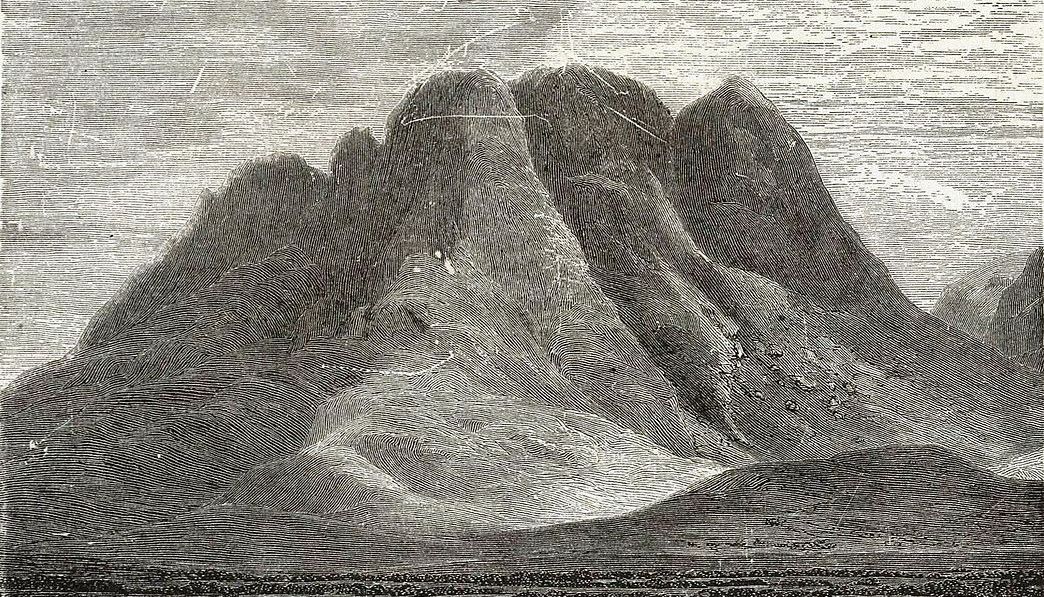Jebel Sin Bishar, Egypt’s Western Sinai Peninsula

In Egypt's Western Sinai Peninsula is Jebel Sin Bishar, or simply Mount Sin Bishar. Israeli geographer Menashe Har-el of Tel Aviv University proposed this site as Biblical Mount Sinai in his 1983 book The Sinai Journeys: The Route of the Exodus. This mountain is used as Mount Sinai in the Zondervan NIV Bible's maps section.
According to Dr. Har-el's research, this mountain is a better fit for Mount Sinai than the traditional location at St. Catherine's in the southern Sinai. According to Jewish historian Josephus' account, Mount Sinai was the highest peak in the region, and Jebel Sin Bishar fits that description as the highest peak in that area of the Western Sinai.
He also states that there are remains of pottery and graves from the middle Bronze age near this mountain, and a widespread presence of chalk and flint in this region, Wadi Suder. According to Exodus 4, Moses' son was circumcised on short notice using a piece of flint.
He gives several more reasons why this more northern spot fits the Biblical account.
Geology: The southern Sinai Peninsula is very dry and has little vegetation. Har-el contends that the Israelites could not have sustained themselves at this traditional location.
Oases: The southern Sinai Peninsula has several oases, but Har-el contends that none of them are mentioned in the Bible. However, the Exodus account mentions several
Food: He also writes that the southern Sinai would not have allowed the Israelites to have enough food (aside from fish from the sea) to survive for very long. In Numbers 11:5, the Israelites complained that they did not have the same diet of fish that they had in Egypt, but if Mount Sinai is closer to the Red Sea in the southern part of the Peninsula, Har-el states that this undermines the claim because the sea was close by and fish could have easily been obtained.
Jebel Sin Bishar is far from the water, but has enough water and vegetation to support the Israelites during the time they were there, in Dr. Har-el's opinion.
Distance: He also claims that the southern Sinai location is beyond a three-days' journey from Egypt, whereas a central-western would be a more reasonable distance.
Midian: One of Har-el's important claims is that the traditional site does not lie near the route to ancient Midian as well. Moses camped at Mount Sinai when returning to Egypt from Midian after his time living in that land. In his estimation, Mount Sinai must have been near the ancient road that connected Midian to Egypt, a road that is still used today for Islamic pilgrimages from Egypt to Mecca.
Egyptian Mines: According to his research, the southern Sinai was controlled by the Egyptians, and they maintained military garrisons in the region to guard the copper and turquoise mines. It is highly unlikely the Israelites would have remained in such close proximity to Egyptian-controlled territory. A location further to the west would be more likely, since it is further away from these areas.
Journey to Kadesh-Barnea: Har-el also claims that from Jebel Sin Bishar, it is an eleven-day journey to Kadesh-Barnea, which would fulfill Deuteronomy 1:2.
Further, the name Jebel Sin Bishar translates to "the laws of man" or "the reporting of the law."
One of the obstacles to further exploration of this mountain is that the Egyptian military has thus far not allowed archaeological study.
Potential Criticisms
One of the arguments for this location, particularly from Gordon Franz, is that this is a location from which the Israelites could have traveled to Kadesh-Barnea in about eleven days (according to Deuteronomy 1:2). Franz suggests that Jebel Sin Bishar is the mountain that fits the distance to this
However, the true location of Kadesh-Barnea is still somewhat obscure. One suggested location is Wadi Musa near Petra, Jordan. If this is Biblical Kadesh-Barnea, then Jebel Sin Bishar would actually be more than 150 miles further away than Jabal Maqla. It would not make sense to claim that Jebel Sin Bishar makes a better candidate than a closer mountain such as Jabal Maqla, or another such as Mount
If Kadesh-Barnea was further northward, such as Ein Qadeish, Jebel Sin Bishar and Jabal Maqla would be approximately the same distance, over 350 km. If Ein Qadeish is Kadesh-Barnea, then both locations would likely become untenable for an eleven-day travel in the ancient world.
Proponents
Menashe Har-el, Tel-Aviv University
Gordon Franz M.A., Associates for Biblical Research
Professor David Faiman
Last updated July 3, 2019.
